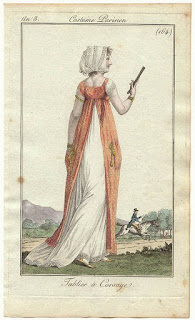Starting its life as the Chemise à la reine (link to Sarah Lorraine Goodman's blog about the chemise à la reine, and here's a link to her master's thesis on the subject) in the 1780s the white muslin dress was an indispensible part of a French woman's wardrobe in the 1790s and early 1800s. It was often worn with a ribbon tied around the waist or, a more complex combination of ties.
I haven't seen exactly this way of tying it in fashion plates, but I was in hurry to take these photos before running off to a meeting, so I decided to go with it as it was (the same goes for the hair, I just curled it and put pins in it at random before tying a silk scarf around it, I will do better the next time. When I have more than 15 minutes). And it does have a cross in the back; the Croisures à la victime, as seen on these costume plates for example. A nice blog post about them can be found here, where you also can read about the Robe à tablier, which I will show one example of further down.
From the front, a very simple version, and the text states that the ceinture is crossed in the back.
The second image shows that if you want the ribbon to stay in a nice shape it is a good idea to stitch it to the the dress, at least in some place.
Here's the dress worn without ribbon, and I like it a lot that way too.
The ribbon used both for the ties and as trim at the bottom is coral pink silk tabby tape and having one, two or three rows of coloured trim on white muslin gowns was very common. Most common colours appear to be sea green, blue, yellow-ish, pink and red.
In many cases the sleeves were trimmed in the same ribbon, but since I wanted to wear this muslin gown with a sleeveless overgown, or probably several of the styles shown below, and not having to match the colour with the ribbons I chose to leave them untrimmed.
The orange coloured one is called a Robe à tablier
I do not, however, plan to let my boobs show quite as much as the last lady.
Other than with a sleeveless overgown and a ribbon I plan to wear it with sleeveless spencers, normal spencers, and an open robe from printed chintz.






























Inga kommentarer:
Skicka en kommentar